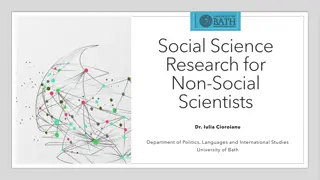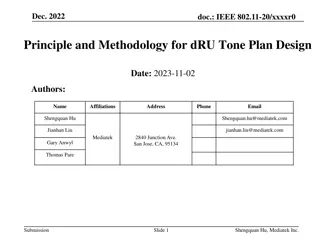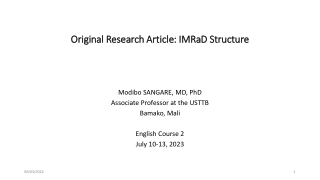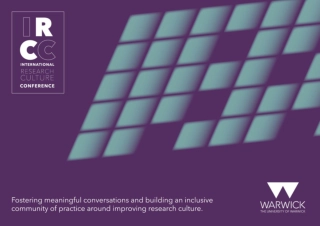Understanding Ethnographic Research Design
Ethnography, a qualitative research method, involves studying people and cultures through observation and interaction in their natural environment. Researchers immerse themselves in the subject group to gain insights, interpret results through a cultural lens, and document findings through detailed analysis. This approach facilitates a deep understanding of human cultures and societies, emphasizing the importance of researcher-participant relationships and knowledge sharing.
Download Presentation
Please find below an Image/Link to download the presentation.
The content on the website is provided AS IS for your information and personal use only. It may not be sold, licensed, or shared on other websites without obtaining consent from the author. Download presentation by click this link. If you encounter any issues during the download, it is possible that the publisher has removed the file from their server.
Presentation Transcript
Welcome Ethnography literally means 'a portrait of a people Ethnography literally means 'a portrait of a people
CONTENTS CONTENTS Ethnography--meaning Key features of Ethnography Steps of Ethnographic Design Types of Ethnography Skills required for conducting Ethnography Ethical guidelines of the design Strengths and weakness of Ethnographic design
learning OBJECTIVES learning OBJECTIVES Enable the student teachers to, define the concept of Ethnographic research Design describe the key features of Ethnographic research explain the skills needed in Ethnographic research enumerate the steps of Ethnographic research elucidate different types of Ethnographic research analyze the strengths and limitations of Ethnographic research
What is Ethnography? What is Ethnography? Ethnography can be briefly defined as the systematic study of people and cultures. It is designed to explore cultural phenomena where the researcher observes society from the point of view of the subject of the study. It is a means to represent graphically and in writing the culture of a group. Ethnography is a qualitative research method where researchers observe and/or interact with a study s participants in their real-life environment. It was initially popular in the field of anthropology, but is now used across a wide range of social sciences. A good researcher is required when observing and/or interacting with target audiences in their real-life environment. Ethnographic studies are usually conducted through interviews, participant observation and surveys.
ETHNOGRAPHY ETHNOGRAPHY- -MEANING MEANING Ethnography research is an approach that focuses on a setting, a group of people and uses the concept of culture as a lens through which to interpret results (LeCompte & J. Schensul, 2010). Ethnographers study human cultures and societies by living among the people they study, by immersing themselves within the subject group The ethnographer participates as much as possible while observing, taking detailed notes, developing an ongoing analysis from the notes and compiling a report about the findings. The relationships between researcher and researched are considered to be an essential element of an ethnographic study. There is active sharing of knowledge between research participants of a culture and ethnographers participating within it
When do we use ethnography? When do we use ethnography? While searching for the meanings of cultural norms and views In trying to understand the reasons for the use of certain behavior or practices For examining social trends and instances like divorce, illness, migration, cultural belief, media usage etc For examining social interactions and encounters To understand the roles of families and organizations and their behaviour To identify new patterns and gain new insights into social phenomenon To understand the hygiene and sanitation practices of communities To observe the types of punishment given to children at school To study the behaviour of workers in an organization
Key Features of ethnographic design Key Features of ethnographic design Usually focus on very few cases, maybe just one, but in detail Often involve working with previously unstudied phenomenon Emphasize on exploring social phenomena rather than testing of preset hypotheses Focus on describing the culture of a group in very detailed and complex manner Involve engaging in extensive fieldwork where data collection is mainly by interviews, symbols, artifacts, observations, and many other sources of data Field-based and is conducted in the settings in which real people actually live, rather than in laboratories where the researcher controls the elements of the behaviors to be observed or measured.
Key Features of ethnographic design Key Features of ethnographic design A holistic approach to the study of cultural systems A process of discovery, making inferences, and continuing inquiries in an attempt to achieve maximum validity An open-ended emergent learning process, and is highly flexible and creative process Interpretive, reflexive, and constructivist process Requires the daily and continuous recording of field notes Tries to earn trust of the respondents
STEPS OF ETHNOGRAPHIC METHOD Selection: The ethnographic method begins with selection of a culture. The researcher selects the culture/ community or population according to his or her interest. Review of Literature: Then the researcher reviews the literature pertaining to the culture to get a brief idea and historical sketch of the culture selected for study. Identification of variables: The researcher then identifies variables which interests him or her as well as the members of the culture and needs to be explored. Entry: The ethnographer then tries to enter the culture and gain the acceptance of the members of the culture Cultural Immersion: Ethnographers live in the culture for months or even years which they have chosen to study. The middle stages of the ethnographic method involve gaining informants, using them to gain yet more informants in a chaining process
STEPS OF ETHNOGRAPHIC METHOD STEPS OF ETHNOGRAPHIC METHOD Data Collection: After gaining the confidence of the respondents, the researcher collects information in form of observational transcripts and interview recordings and tapings Analyses of Data : From the many sources collected, the ethnographer analyzes the data for a description of the culture-sharing group, themes that emerge from the group and an overall interpretation. The researcher begins to compile a detailed description of the culture-sharing group, by focusing on a single event, on several activities, or on the group over a prolonged period of time. Generalizations; Forge a working set of rules or generalizations as to how the culture-sharing group works as the final product of this analysis. The final product is a holistic cultural portrait of the group that incorporates the views of the participants (emic) as well as the views of the researcher (etic).
TYPES OF ETHNOGRAPHIC RESEARCH Macro ethnography: It is the study of broadly defined cultural grouping such as eco-friendly practices of tribes in India . The common perspectives are studied at a more larger level, which are found to be common under a more broader strata. Micro ethnography: It is the study of more specific cultural groupings such as the religious practices of tribal people in kerala . Emic perspectives: It is the ethnographic approach under which the viewpoints and responses of the ingroup or the members of the culture understudy are noted down Etic perspective: It is the ethnographic approach under which the viewpoints and responses of the outgroups or the members who do not belong to the culture under study are noted down. Their viewpoints highlight the phenomena being followed under a particular culture
Skills required for Ethnographic Studies Skills required for Ethnographic Studies High degree of interpretative agility is required to understand the wide range of issues and facts involved in the study. The researcher needs to be unbiased and unprejudiced in order for the study to draw valid and reliable conclusions .The researcher needs to be familiar with the social settings and needs to have a high degree of intellectuality and diplomacy. The researcher needs to possess good interactional and inter-personal skills. The researcher needs to be sensitive towards the culture, values and norms of the social setting in which the study is being conducted. The researcher needs to be familiar with the tenets of research ethics
Ethnographic design Ethnographic design-- --Do s Do s Have an open mind, free of any kinds of prejudice or biasness Keep a simple stature so that the people feel comfortable and act naturally Be diplomatic and supportive towards the views and opinions of the subjects A prior study and understanding of the group and the environment is vital for a good ethnographic study Good understanding of social science theory, research methods and research design is important for conducting ethnographic studies Think about what you are going to ask beforehand and get familiar with the questions During an interview try to put your respondents at ease and choose a setting where your interviewee will feel safe and comfortable Conduct the study in a relaxed and stress free mood Always keep in mind to respect the ethics and norms of the group under the study
Ethnographic design Ethnographic design-- --Don ts Don ts Do not interrupt and simply observe Never put pressure on the study subjects Do not offend the culture, values and norms of the group under study Do not over dress and keep the actions limited Never distort the facts to meet the research aim Never go unprepared and without prior understanding of the group Never cross the ethical boundaries to conduct the research
Strengths of ethnographic design Strengths of ethnographic design First hand insights--As the researcher has interacted, experienced as a participant and observed with the participants firsthand, they can be sure of the insights that surface reliably. Detailed data--The length of the time spent with the participants, probing and observations lead to rich and detailed data collection. High reliability--Because the researcher is directly engaged with the group participants and immersed into the group, the data collected is not from external or from individuals outside of the group under consideration. The data collected is highly reliable. Close-interaction--The ethnographic researcher is a participant within a group or culture, and involved closely with the other participants, they can develop perceptions, which can give them a peek into the lives and experiences of the participants within their culture. This also helps the researcher gain a deep understanding of different perspectives of individuals.
Weakness Weakness of ethnographic design of ethnographic design Time-consuming--A good ethnographic research study will require a huge time commitment from the researcher s end. For studies that can go on for years at a stretch, researcher needs to stay part of the group for a long time. Diversity of results--The large number of participants and the extended exposure to their thoughts, preferences, cultural backgrounds and behavior can generate large amounts of diverse data which can pose a challenge to collate. Reliability--As the researcher is solely involved in the group, it s difficult to validate the reliability of data collected and insights generated. Researcher Bias--As the researcher is engaged first hand with the other participants being studied, they are likely to introduce bias. Participant reservations--If the role of the researcher is well known to the group participants, they may not always be open to sharing their perspectives.
Summary Ethnography is a qualitative research method where researchers observe and/or interact with a study s participants in their real-life environment. It is a systematic study of people and cultures. It is a means to represent graphically and in writing the culture of a group. It is designed to explore cultural phenomena where the researcher observes society from the point of view of the subject of the study..
Suggested readings Suggested readings Hammersley, Martyn, & Atkinson, Paul (1995). Ethnography: Principles in Practice, Second Ed .London: Routledge. Neuman, W. L. (1994). Social Research Method: Qualitative and Quantitative Approaches (2nd ed.). Bostin: Allyn & Bacon. Kothari,C.R. (2008). Research Methodology Methods and Techniques (second revised edition). New Delhi: New Age International. McMillan, J. H. & Schumacher, S. (1993). Research in Education: A Conceptual Understanding. New York: Haper&Collins. Punch, K. (1998). Introduction to Social Research: Quantitative and Qualitative Approaches. London: Sage

















































